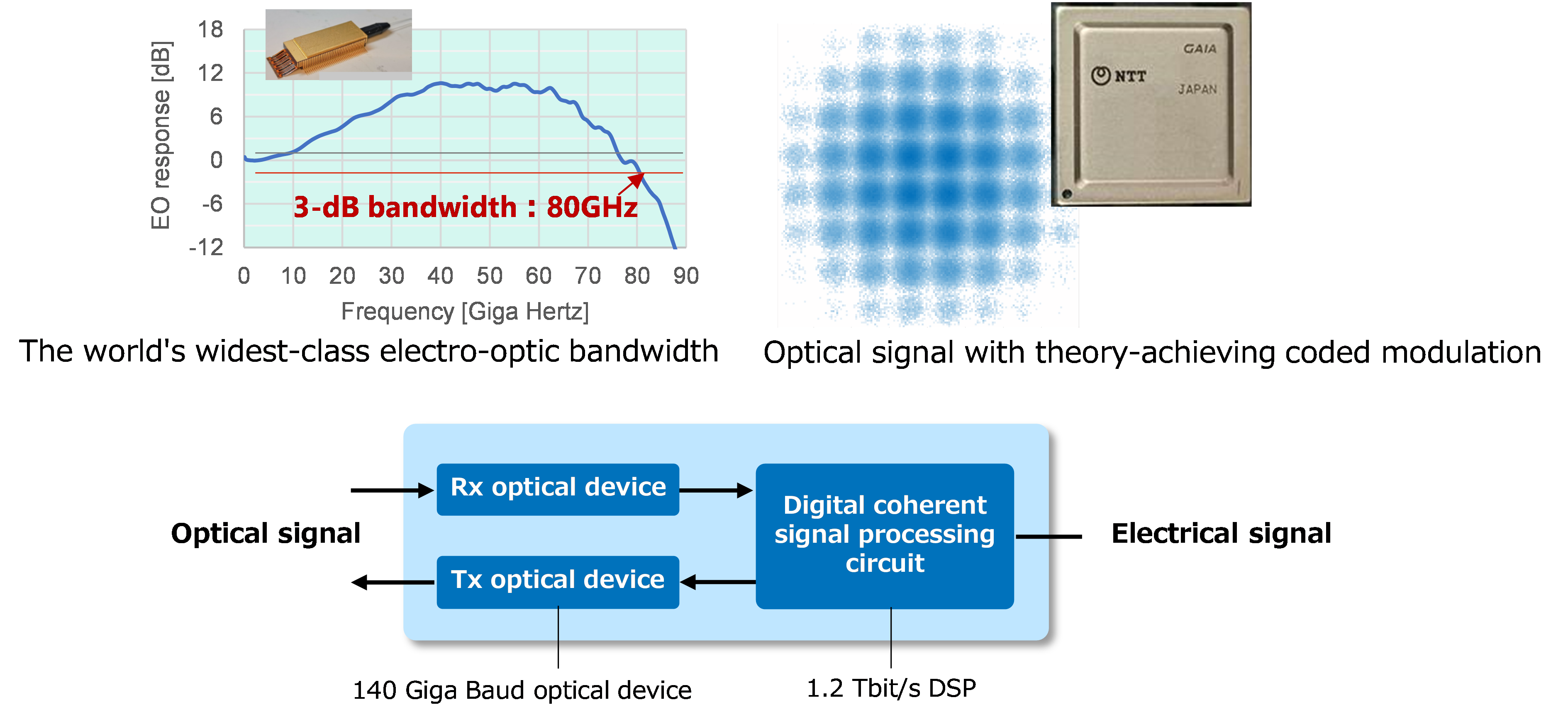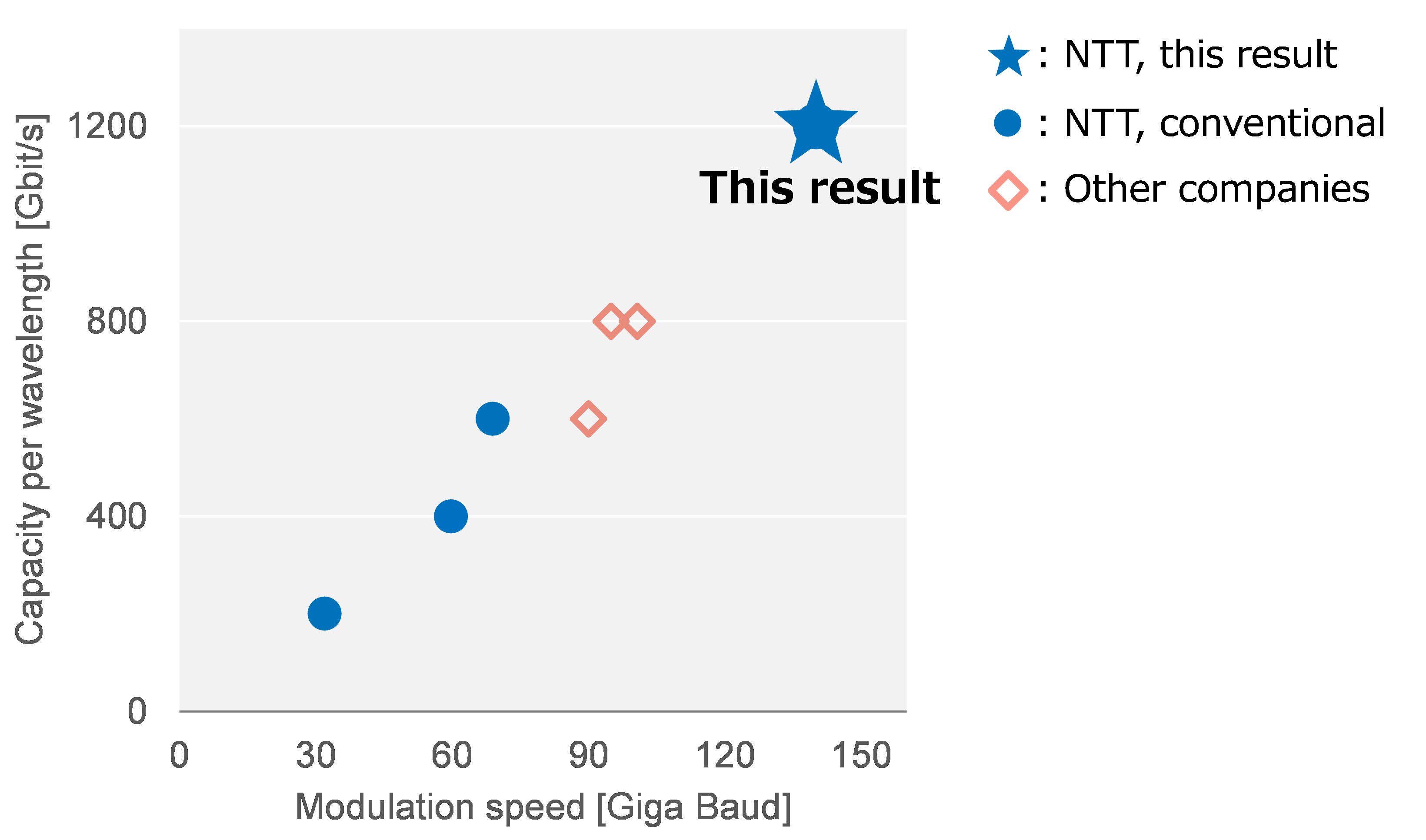Microsoft ends support for Internet Explorer on June 16, 2022.
We recommend using one of the browsers listed below.
- Microsoft Edge(Latest version)
- Mozilla Firefox(Latest version)
- Google Chrome(Latest version)
- Apple Safari(Latest version)
Please contact your browser provider for download and installation instructions.
September 5, 2022
NTT Corporation
World's largest capacity of 1.2 Tbit/s per wavelength by newly developed digital coherent signal processing circuit and optical device
- For larger capacity, longer transmission distances, and lower power consumption in optical networks -
NTT Corporation (NTT, Head office: Chiyoda-ku Tokyo; President & CEO: Akira Shimada) has developed a digital coherent (*1) signal processing (coherent DSP) circuit and optical device that achieves the world's largest capacity of 1.2 Tbit/s per wavelength for optical transmission.
By using the proprietary developed device, we have increased the optical signal modulation speed to the world's highest 140 Giga baud and achieved 1.2 Tbit/s per wavelength, which is 1.5 times faster than before. Also, the developed device enables to double the optical transmission distance of 800 Gbit/s.
As a result, the capacity of optical transmission system will be increased by 12 times and the power consumption per bit will be reduced to 10% of the widely-used commercial system (100 Gbit/s per channel). The improvements in the performance and power consumption of optical transmission systems should contribute to an all-photonics network in the IOWN (*2) concept.
 Fig. 1. Developed device
Fig. 1. Developed device
1. Background
With the increasing distribution of video data and cloud applications, new information communication services such as 5G services, and the rapid growth of remote work, information communication traffic has been increasing and will continue to increase in the future. Thus, it is necessary to reduce the power consumption and cost required for transmission per unit bit in backbone optical communication networks at a rate of about 1/10 every ten years.
However, with conventional technology, it has been difficult to sufficiently reduce the power consumption of communication devices that accompanies further increases in their capacity. Toward this end, NTT has been developing advanced optical transmission technology and optical device that can economically and significantly expand the capacity of existing optical transmission systems.
2. Developed device
Our developed device utilizes a digital coherent detection scheme, in which the polarization, amplitude, and phase of light are captured as digital data. The signal distortion that occurs in the optical fiber transmission channel and optoelectronic devices are compensated and equalized through advanced signal processing. Figure 1 shows the configuration of an optical signal transceiver with a maximum transmission capacity of 1.2 Tbit/s. The transceiver consists of a cutting-edge coherent DSP circuit (Fig. 1 upper right photo) and a 140-Giga baud class optical device with the world's widest-class opto-electrical response bandwidth (Fig. 1 upper left photo).
2.1 Coherent DSP circuit
The coherent DSP circuit combines cutting-edge coded modulation (*3) with transmission performance approaching the theoretical limit and newly developed forward error correction (*4) that can correct bit errors in large amounts of data with low power consumption. This results in flexible coded modulation (*5) that maximizes the potential of the high-speed optical devices. Furthermore, by utilizing a power-efficient algorithm to equalize signal distortion in the optical fiber transmission channel and the advanced CMOS (*6) processes, we have achieved a digital signal processing of 1.2 Tbit/s per wavelength with low power consumption.
2.2 140 Giga baud class optical device
We have developed an ultra-high-speed optical transmitter device that uses the world's fastest-class optical modulator chip with NTT's original structure and a newly designed low-loss high-speed interface.
By applying these developed devices and schemes to polarization division multiplexed 64QAM (*7), we have achieved optical transmission at 1.2 Tbit/s per wavelength.
2.3 Comparison with existing technology
With this developed devices, the transmission capacity can be increased to 1.2 Tbit/s per wavelength, which is 12 times faster than the widely-used commercial optical transmission system (100 Gbit/s per wavelength). By expanding the transmission capacity per wavelength, the power consumption per bit can be reduced to less than 10% of the existing optical transceivers.
Figure 2 shows the results of our developed technology compared with the existing technology. The maximum capacity per wavelength achieved so far in the world was 800 Gbit/s. Our developed device has increased this by 1.5 times. It may be possible to use a higher multi-level modulation format to increase the capacity per wavelength, but this limits the transmission distance. In our approach, by increasing the modulation speed from 100 Giga baud to 140 Giga baud, the degree of QAM levels can be suppressed, resulting in higher resistance to waveform distortion and optical amplification noise caused by transmission. As a result, the transmission distance of 800 Gbit/s signals can be extended by more than twice that of the 100 Giga baud devices.
 Fig. 2. Comparison with existing technology
Fig. 2. Comparison with existing technology
3.Future directions
Toward the development of the IOWN, NTT aims to create an innovative network with high capacity, low latency, flexibility, and low power consumption by continuing to expand and develop end-to-end photonics technology. We will promote the creation of economical, large-capacity, low-power-consumption networks by leveraging advanced optical transmission systems based on the innovative technology. We also intend to collaborate with both international and domestic partners so that our developments can be valuable and beneficial for communities worldwide.
Supplement:
This work was partially supported by the Ministry of Internal Affairs and Communications (MIC), Research and Development of innovative optical network technology as a new social infrastructure (Technological Theme I) and The research and development of advanced optical transmission technology for a green society (Technological Theme I) (JPMI00316).
Terminology
*1Digital coherent
Digital coherent technology is a transmission method that combines digital signal processing and coherent detection. Coherent detection can capture the amplitude and phase of light by using the light interference between the received signal light and local laser light on the receiving side. This enables polarization division multiplexing and phase modulation and can improve frequency utilization efficiency. In addition, coherent detection enables precise equalization of optical signal distortion by using digital signal processing and significantly improves reception sensitivity.
*2IOWN:
The news release of "NTT Technology Report for Smart World:What's IOWN?"
https://group.ntt/jp/newsrelease/2019/05/09/190509b.html
*3Coded modulation
A modulation method that controls the symbol occurrence probability distribution of an optical signal.
*4Forward error correction
Bit errors caused by noise addition or signal distortion during information bit transmission are detected and corrected on the receiving side by assigning redundant bits in advance on the transmitting side.
*5Flexible coded modulation
The amount of information bits per symbol and modulation rate can be flexibly selected on the basis of the bandwidth characteristics of the optical device and the desired transmission distance.
*6CMOS:
Complementary Metal-Oxide-Semiconductor
*7Polarization division multiplexed 64QAM
Quadrature Amplitude Modulation (QAM) is a modulation method that carries information on both the amplitude and phase of signal light. 64QAM can send 6 bits of information at each symbol. By applying this modulation method to each of the two independent polarization dimensions of the optical fiber, the transmission capacity is doubled.
Media Contact
NTT Corporation
Science and Core Technology Laboratory Group, Public Relations Section
nttrd-pr@ml.ntt.com
Information is current as of the date of issue of the individual press release.
Please be advised that information may be outdated after that point.
NTT STORY
WEB media that thinks about the future with NTT










